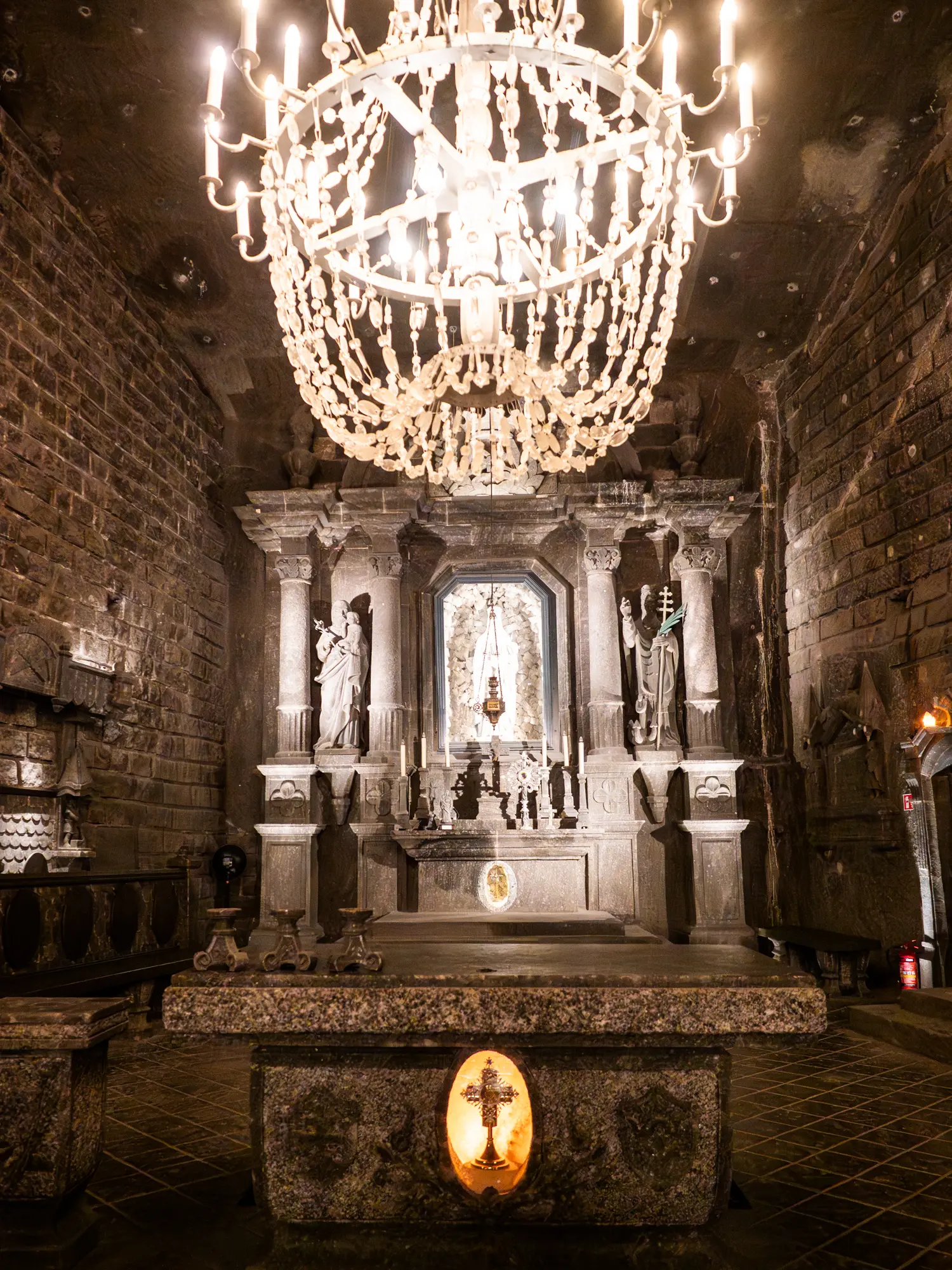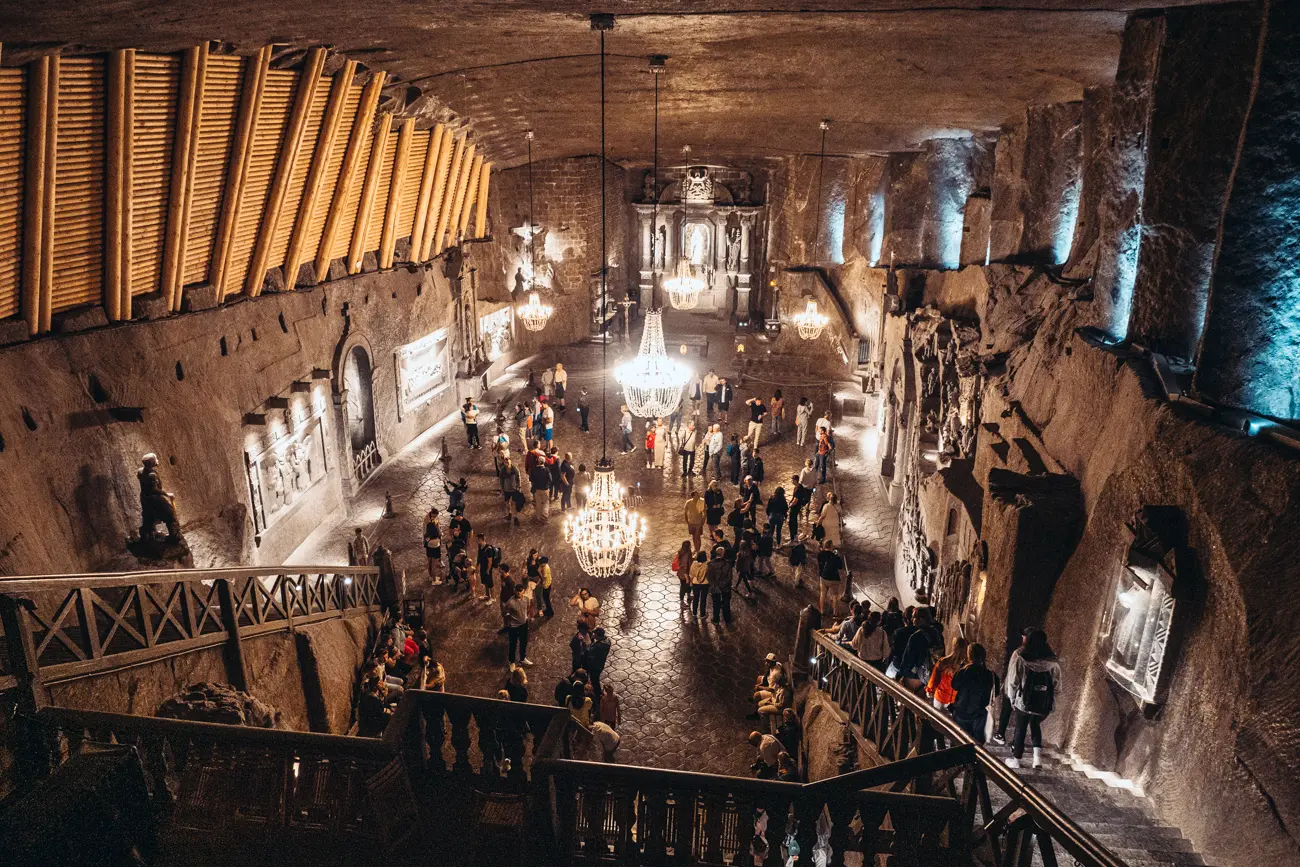Imagine stepping into a world where the walls sparkle like diamonds, the chandeliers are made from salt and the air is healing. Welcome to Wieliczka Salt Mine, a historic gem hidden beneath the city of Wieliczka on the outskirts of Krakow.
I first visited this UNESCO World Heritage Site 10 years ago and recently returned with my sister. A lot had changed since my first time there, the biggest difference being the insane amount of people.
So is it still worth visiting? Yes, but…
I’ll get to what I mean by that, but first, let’s take a closer look at how to get to Krakow Salt Mine, the best time to visit and what you can expect while you’re there.

Article overview
Wieliczka Salt Mine quick overview
Depth and length: The mine reaches a depth of about 327 meters (1,073 feet) and stretches over 287 kilometers (178 miles) of tunnels.
Temperature: The temperature inside the mine is consistently around 14-17°C (57-62°F), so bring a light jacket or sweater. I wore a shirt dress on both visits and was fine, but then again I’m Norwegian haha.
Tour duration: Guided tours typically last about 2-3 hours, covering approximately 3.5 kilometers (2.2 miles) of the mine. That includes bathroom and snack breaks. So between getting there, waiting in line and the tour, expect to spend half a day. You can see how I recommend you spend your time in my Krakow weekend itinerary.
Accessibility: The mine has numerous stairs (about 800 steps) and uneven surfaces, which may be challenging for those with mobility issues. However, there are special tours available for visitors with limited mobility. Prior booking is required, email rezerwacja@kopalnia.pl.
Assistance dogs or guides for blind and visually impaired people are allowed. Guided tours are available in multiple languages.

Getting there
We got up early to get to the mine before it opened at 8:00 am. Since we were staying in Kazimierz (south of the old town), and were four people, the most time and cost-efficient transportation option was to get a Bolt.
I do not recommend renting a car in Krakow (if you’re limited on time or only staying in the central parts), so let’s take a look at the best transportation options for the 12-kilometer journey.
By taxi or ride-sharing
Taxis and ride-sharing services like Uber and Bolt are readily available in Krakow. I often find that Bolt is the most affordable option, we only paid 25 PLN ($6.5), while the taxi ride home cost us 75 PLN because we didn’t want to wait for a Bolt. There is usually a line of taxis waiting next to the square close to the mine exit.
By public transport
If you’re staying closer to the Old Town, one of the most efficient ways to get to Wieliczka Salt Mine is by train. Head to Krakow Glowny (next to Galeria Krakowska), the main railway station in Krakow.
From there, hop on a train bound for Wieliczka Rynek-Kopalnia. The journey takes 21 minutes, and trains run frequently throughout the day. You can find the exact times and book tickets (6.5 PLN) through the Koleje Małopolskie page.
Once you arrive at the Wieliczka Rynek-Kopalnia station, the mine entrance is just a 500-meter walk away. If you have the time, consider getting a train day pass so you can visit Auschwitz as well on the same ticket.
You can also catch bus number 304 from the Dworzec Główny Zachód stop opposite Galeria Krakowska. It takes 40 minutes, and you’ll want to get off at the Wieliczka Kopalnia Soli stop. But a 1-hour ticket costs 4 PLN so the train is really the best option.
Click here for the official map of public transport stops and parking at the mine.
By guided tour
Or if you are limited on time and don’t want to do any planning, I recommend booking this half-day guided tour that includes hotel pick-up. It is the best value option I could find online that also lets you choose an early time slot.
I like booking my guided tours through big sites like Viator or GetYourGuide because you get free cancellation up until 24 hours before the tour. And you can reserve now and pay later.

History of Wieliczka Salt Mine
I loved listening to our guide explain the history of Wieliczka Salt Mine which spans centuries, from medieval times through industrial advances and transformation into a modern tourist site.
Legend has it that the mine was discovered in 1252 when Saint Kinga of Poland, a Hungarian princess, threw her engagement ring into a salt mine in Hungary, and it miraculously appeared in Wieliczka.
Expansions were driven by the increasing demand for salt, often called “white gold” due to its high value, which was essential for food preservation and seasoning.
During the industrial period, steam engines and mechanized tools replaced manual labor, increasing production efficiency. But you can still see the old ways of how the mine was run today. We got to try spinning a huge wheel that hoisted the salt out of the mine. I can’t even begin to imagine having to do that every day for 12 hours.
In 1978 Wieliczka Salt Mine became a UNESCO World Heritage Site because of its immense cultural and historical significance.
In 1964, rock salt mining stopped in favor of the wet method. But the mine is still a big part of the local economy through tourism, attracting over a million visitors annually.

Buy your tickets
Tickets for the Wieliczka Salt Mine can be purchased online or on-site. Online booking via the mine’s official website is recommended, especially during peak season. This ensures entry at your preferred time and reduces waiting in line.
As mentioned above, you can also book a guided tour from Krakow and everything will be taken care of for you.
Once we arrived at the Wieliczka Salt Mine entrance, the first thing we saw was a line of people under a canopy tent. To the right is the ticket window where you have to get in line to buy your tickets if you haven’t done so online.
It is kind of hidden behind a stall selling souvenirs and snacks, so it took us a while to understand where to go. Luckily we got there early so only two people were in front of us. They will ask which time slot you want so just say the next available.
Tourist or Miner’s Route
The Tourist Route is the most popular and accessible option, designed for visitors of all ages and fitness levels. This guided tour takes you through some of the mine’s most spectacular chambers and highlights its historic and artistic treasures.
The Miner’s Route offers a more adventurous and immersive experience, allowing you to step into the shoes of a Wieliczka miner. This tour is ideal for those who want to explore lesser-known parts of the mine and get a hands-on taste of mining life.
Wieliczka Salt Mine entrance fee >> Both routes cost 134 PLN ($35) for a standard ticket and 112 PLN for the reduced ticket (children under 10, students and seniors).



What to expect at Wieliczka Salt Mine
When you have your tickets you can walk around and look at the souvenirs, buy some snacks or sit down at the restaurant. You don’t have to stress about getting in line because everyone will get in at their chosen time. Just get there 5 minutes before.
We had to wait for the second time slot of the day, even though we got there right before opening. So when it was finally our turn, our line was divided into groups of around 15 people and we met our guide.
Our exploration began by going down 53 flights of stairs if I remember correctly. My legs were vibrating when we finally got to the bottom. And the guides do this many times a day, they must have incredible leg muscles 😏
The tourist route takes you through a maze of tunnels, enriched with interactive exhibits and informative displays. We witnessed centuries-old mining machinery and got some great bits of information from our guide along the way.
Although well-lit and generally comfortable, remember that sturdy footwear is recommended due to uneven pathways.

The highlight of the tour is the breathtaking Chapel of St. Kinga, 101 meters underground. You get 15 minutes here to make sure you get some photos and time to take everything in.
This stunning subterranean chapel is a true marvel, carved entirely out of salt by the talented miners who worked here. Named after Saint Kinga, the patron saint of salt miners, the chapel is a testament to their skill and deep faith.
As we walked through the chapel, we were awestruck by the details: the altarpieces, intricate statues, and even the floor tiles, all crafted from salt. And to top it off, the large salt chandeliers cast a warm glow making the walls and ceiling glisten.




The mine is also home to an array of carved figures and bas-reliefs, depicting religious icons, historic scenes, and folklore, each crafted with meticulous detail from rock salt.
My favorite bas-relief in Wieliczka Salt Mine is the depiction of The Last Supper (above). Inspired by Leonardo da Vinci’s famous painting, this salt-carved masterpiece can be found in the Chapel of St. Kinga.
The Nicolaus Copernicus Chamber houses a striking statue of Copernicus himself. He was the first well-known person to visit the mine. Crafted to commemorate the 500th anniversary of his birth, this sculpture celebrates his contributions to science and his connection to Polish heritage.

You’ll also see some wooden figures and machinery showing what life was like in the mine.


Wieliczka Salt Mine is also home to several green lakes filled with water so salty you could float without any concern of drowning. I think our guide said one of the lakes was 4 times more salty than the Dead Sea (please correct me if I’m wrong).

Getting out of the mine takes about 30-45 minutes depending on how busy it is. You can choose to visit the museum or get straight in line to exit.
Luckily you don’t have to walk back up the 53 flights of stairs. When it’s finally your turn, you are led through a maze of tunnels and then loaded onto an elevator to make your way up to the top.


Practical visitor’s information
To round this article off, here are some quick bits of information to make your visit to Wieliczka Salt Mine as smooth as possible.
Opening hours
Regular hours during the high season are from 8:00 am to 5:00 pm. On weekends the Tourist Route is open until 6:00 pm. Admissions every 30 minutes.
In winter opening hours are shorter: 09:30 am to 03:00 pm on weekends and 10:00 am to 05:00 pm with admission every hour during the week.
The mine is closed on January 1st, Easter Sunday, and December 24th and 25th.

Amenities
At Wieliczka Salt Mine there are gift shops along the way and at the end. Choose from salt lamps, figurines, skincare and other souvenirs that capture the essence of the mine. I got a rock salt grinder, a “gold” coin for my collection and some candy.
Toilets are also available underground in two locations. They were quite busy so use the bathroom before the tour starts or at the end.
There’s also a restaurant serving hearty traditional Polish dishes. There was a lot of space to sit down for a relaxing meal before you continue to the museum or exit the mine. About halfway through the tour, there’s also a snack bar.


For special occasions, there are several event spaces available for hire, one at a depth of 125 meters. You can also book tickets for the New Year’s Eve celebrations called Rock & Salt Underground. At 1100 PLN the price is steep but what an incredible experience.

Spend the night
If you want to spend some more time here you have the option to sleep 135 meters underground, in a healing microclimate or in the comfortable rooms of the Grand Sal Hotel on the surface.
I wish I had stayed underground because the air is free from allergens and rich in micro-elements which brings relief to those who suffer from allergies and respiratory issues. It also improves the body’s immunity, which has always been a problem for me.
The clinic boasts modern equipment and experienced medical staff offering personalized treatments to accommodate different health needs. Click here for more information and booking.
You also have the option to do a health day. A 6-hour outpatient treatment stay underground in a salt chamber under the care of a doctor, nurse and physiotherapist.

Is Wieliczka Salt Mine worth it?
So to finish what I said in the intro, yes Wieliczka Salt Mine is worth visiting… but I wouldn’t skip the main attractions in Krakow to see it.
Meaning if you have very limited time in the city, there are more important things to see and do such as Wawel Castle, Rynek and Kazimierz. Krakow is also home to many hidden gems, some of which I would prioritize especially if visiting during the warmer months.
Bochnia Salt Mine is a lesser-known alternative, though a little further out from Krakow city center.










Leave a Reply